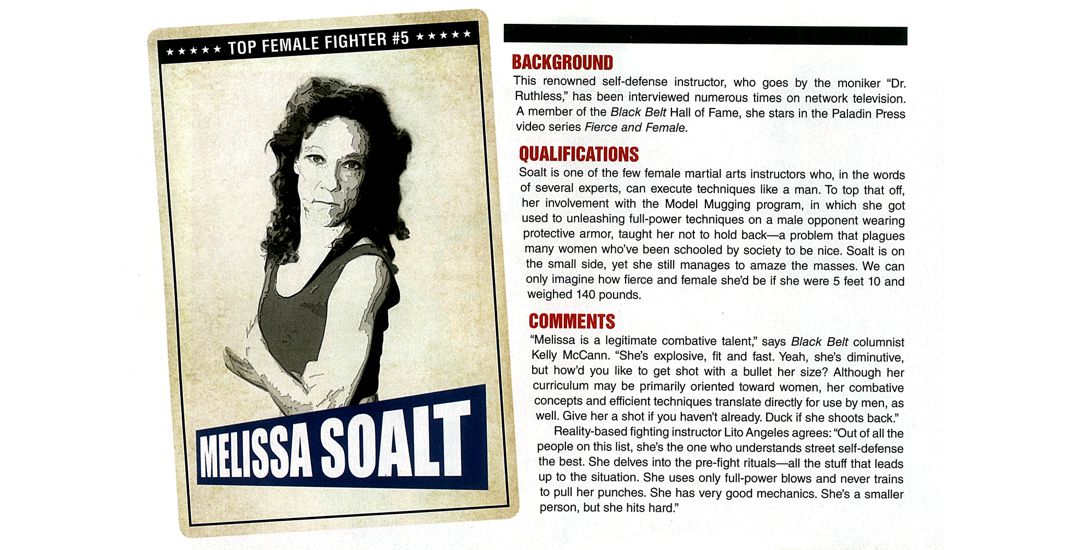So you finally decide it’s time to learn self defense. Perhaps recent events stirred some What if scenarios. As you take your evening stroll or board a plane, you fretfully wonder, Could I take that guy? Could I escape his clutches? What about that guy behind him?
Off you head to the nearest martial arts school or warrior woman class. Off come the makeup and jewelry; on goes the uniform or sweat suit.
The drills—striking, kicking and hitting the pads—are just what the doctor ordered. Your confidence rises and your fear recedes. Then, just when you thought you had it wired and it’s time to deliver your first real blow against a sparring opponent or maybe a menacing padded attacker, some unexpected force hijacks your body and holds you back. Instead of charging in, you recoil, cringe or maybe even cry. Your warlike kiai (martial arts shout) or snarling “No!” is usurped by a timid, “You want me to what?” It’s unmistakable: You feel like prey—and it’s as infuriating as it is terrifying.
If this sounds like you, or how you imagine yourself feeling, relax. You’re not a wimp, and you’re definitely not alone. “So when’s the last time you struck someone in the head, drove an elbow into a throat or kneed a groin?” I ask women to quell their anxieties. The cringe response is natural; it’s part of what gets re-conditioned.
We have come a long way, baby. But some things can’t always be erased in a few punch-and-kick lessons. It takes some grubby work to blast through fear and get those fierce survival instincts back on line. Once unearthed, these primordial powers are potentially lifesaving—as gracious as they are gritty.
The Perils of Socialization
Let’s face it: Few women are groomed for combat. Until recent times, fighting back in self defense wasn’t even on the map; avoidance behaviors—a litany of “don’ts”—were women’s primary form of self-protection, imprinting fear deep into the female psyche. On the contrary, fighting back and baring the teeth goes against the grain of feminine and cultural conditioning—a system of rewards and punishments which, by and large, rewards women for being pretty not fierce, courteous not confrontational, and values looks over competence. All these factors can atrophy your female-animal muscle. It’s precisely this pacification and disconnect from our baser selves that fosters victimization, increasing our vulnerability to being snared by a predator.
Now the good news: survival is hard-wired in all creatures and human females are no exception. Just as we’re endowed with a maternal instinct, so too are we equipped with the capacity for aggressive self-protection—the ability, when all else fails, to trade in our polite selves for our animal selves and save our own pretty skins. Knowing that you too can be a dangerous creature and not just the endangered one lies at the heart of female safety. This attitude is essential to survival, to warding off creeps and predators who roam the human jungle. And it embodies the true spirit of reversal, a term which denotes turning the tables on your attacker in a potentially lifesaving “switch.” Embracing this attitude reminds us that our bodies, not just our hearts and minds, are instruments of power.
Popping the Corset of Constraint
Practical self defense is ultimately a blend of technique and fighting spirit, strategies and instinct, skill and will (something women possess in ample supply). It isn’t just a matter of doing, but of undoing. To recoup your primordial other self and liberate the fighter within, you must throw off the yoke of conditioning and shed dangerous misconceptions that could hold you back or generate potentially fatal hesitation.
To get your fighting heart pumping and back on line, work on purging these myths from your psyche:
Myth of Female Defenselessness
We’ve heard it a million times: Men are the warriors and protectors, women are the nurturers and protectees; our bodies are too fragile, our spirits are too weak, we aren’t made of the right stuff to fend off predators. In other words, we are helpless in the face of an attack. Nonsense! It’s precisely these internalized “can’t do” messages that sabotage women’s self-protective abilities, quelling our more primitive and heroic instincts, courtesy of Mother Nature.
While we do have some disadvantages, women also possess some unique strengths: speed, agility, surprise, cunning, good intuition, a lower center of gravity (excellent for balance and maintaining a base of power) and powerful emotional reserves that can transform petite women into formidable forces of nature. But unable to protect ourselves? Hooey! Tell that to my student who, when accosted by a group of thugs, made pulp out of the ringleader’s groin and knocked his accomplice unconscious before making a getaway. Or my friend whose slender legs immediately went into action kicking like a madwoman when a psycho, disguised as her kitchen trash bag, leapt up and attacked, knocking her to the tile floor. Her relentless kicks and screams, fueled by terror, worked—her attacker fled out the window. This, not Hollywood stunts, is real self defense.
I’m Afraid I Don’t Have It in Me
Sure you do. This just calls for a little reversal of thinking. Think way back to once upon a time in prehistoric days, when we coddled our young one minute then stomped on snakes and speared marauding bears the next. Strength and survival, not just fear, dictated our every move; our nurturing and aggressive natures entwined seamlessly. Thankfully, we’ve evolved: We’re less hairy and more upright with bigger brains and better makeup, but the Beast Woman rocks on. And she is with you all the time, lurking beneath the modern day veneer. Recovering this ancient capacity is one of the many benefits of self defense training. But even without training, when a woman’s survival or integrity is threatened, this innate ability routinely punches in.
But I’m So Small and He’s So Big
There’s a wonderful saying: “It’s not the size of the woman in the fight, it’s the size of the fight in the woman.”
I don’t want to sugarcoat the harsh realities of being attacked, nor the benefit of being strong and in good shape. However, size, shape, prowess, or the fact that women have less muscle mass than men, ultimately has little to do with survival.
When engaged in a battle for survival, fighting spirit often prevails; will is as important as skill! The combination of resolve, willpower, determination and fury are often our most formidable weapons. Intention fueled by fighting spirit really is the mother of technique. It can work like a charm, filling women with “supernatural” powers that become their saving grace.
In her self defense book, Attitude, Lisa Sliwa, co-founder of the Guardian Angels, recounts her brutal attack by three “well-groomed” men who beat then attempted to rape her in an abandoned city building. What saved her wasn’t fancy technique but the power of will, her uncompromising decision that “the angry man kneeling over me was not going to rape me.” “What that day showed me,” she wrote, “was that it isn’t your physical strength that’s going to help you get through a violent situation. It’s your attitude. My commitment to survival is what saved me.”
Fear, Risk and Submission
Fighting back (or using a weapon) is always a last resort, but it may be the only one that saves your life or integrity. Of course it carries risks and, yes, you might get hurt. Visualize it and become accustomed to the idea— as though being raped, beaten or worse doesn’t constitute injury?
The consequences of submitting may even be grave. Sexual assaults can quickly escalate into life-threatening situations. Instead of fixating on fear and succumbing to a criminal’s disingenuous words (“Do what I say and you won’t get hurt,” for example), you must ask yourself, “What will happen if I don’t take immediate action and facilitate escape?”
Thankfully, research on resistance strategies has dispelled the myth that fighting “makes things worse.” Immediate and aggressive responses are effective. Conversely, pleading, reasoning or appealing to a criminal or rapist’s humanity is not—the latter being “almost universally futile,” notes Dr. Judith Herman, author of the bestselling book Trauma and Recovery.
Tragically, the fear of injury, partially instilled through feminine conditioning, is far more injurious to women than resisting attack, particularly when we possess the explosive skills, tactical thinking and fighting spirit to back it up. Good self defense training not only arms you with strategies and the ability to realistically assess your situation, but it also liberates courage, and the ability to move beyond fear.
Anyone who has been there knows: The aftermath of assault can be devastating, resulting in nightmarish trauma that, in the words of many survivors, “never really ends.” Whether or not a woman fought back can make a huge difference in her recovery. “The women who fought to the best of their abilities were not only more likely to be successful in thwarting the rape attempt, but less likely to suffer severe distress symptoms,” writes Herman. “By contrast, women who submitted without a struggle were more likely to be highly self-critical and depressed in the aftermath.”
But what’s most important is that you possess the option to fight and are prepared in body and spirit to do so. While there’s no substitute for good judgment in the moment, decide in advance where you draw the line: What is non-negotiable? What is worth fighting for?
Changing the Face of Female Fear
All women possess the powerful inner resource of self-protection. This instinct lies deep within us all. Unearth it. Respect it. Learn to bring it to bear. Recouping this power is not only life saving, but life changing. Once you own your capacity for dangerousness, you not only become safer, you become more whole.
COPYRIGHT © NOTICE: This article is protected by Copyright law. NO copy, reproduction or reprinting without written authorization. All rights reserved.






